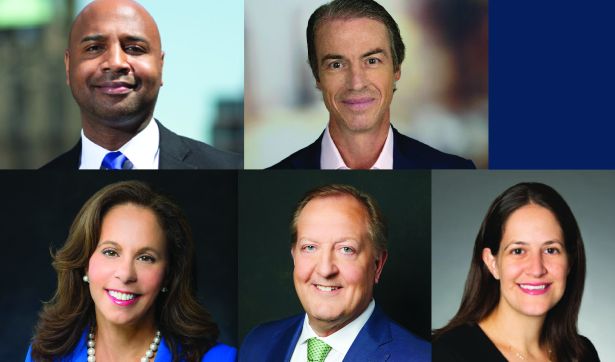COVID’s Changed the Manhattan Office Market Forever, Experts Say
Commercial Observer gathered many of the top names in the field in October
By Aaron Short October 20, 2021 6:20 am
reprints
Now that a fourth wave of the coronavirus pandemic may finally be cresting, employers are beginning to plan for the future with an eventual return to the office.
Maybe because of that, Manhattan leasing activity perked up after a long dry spell with 2.4 million square feet leased in July, the third month in a row that commercial leases increased, according to a report from brokerage Colliers.
The news has not been entirely rosy. Investment sales activity was 35 percent below the pre-pandemic monthly average in 2019 and a record-high 17.1 percent of office space is currently on the market, according to the report. But, for brokers and property owners, that also represents a precious rare opportunity for companies to claim a stake along some of the planet’s most covetous corridors of commerce.
Such were the main themes that emerged during Commercial Observer’s, “State of the Leasing Market: Adapting for a Fluid Market,” forum on Oct. 6.
Durst Organization Chairman Douglas Durst declared that “those who bet against the city will lose,” although he acknowledged that the city’s commercial market has a long way to go.

“I believe that the market possesses the same elasticity and ultimate resiliency as sectors that have more clearly rebounded,” Durst said. “The trajectory of the commercial office market early this summer was extremely positive, but the delta variant caused many tenants to delay their return. Still, we have seen a steady increase in office occupancy this fall.”
Property owners have been busy modernizing their assets and adding health-conscious amenities that are nearly requirements in today’s market. That has meant not only providing enough outdoor spaces to provide fresh air and circulation but a floor plan that also spurs camaraderie and productivity.
“It’s not just physically having outdoor space or a new lobby, it’s to bring people back to a sense of excitement and community so they could tell their employees, ‘We’ve chosen XYZ building because of the following reasons,’” David Falk, Newmark’s tri-state president, said.

But office workers have been productive working remotely, whether from home or farther-flung locations. Now that workers have spent the past 18 months using Zoom, they are looking for compelling reasons from their bosses why they should return, brokers and builders say.
“What they’re looking for are interaction points that really take them from a basic level of, ‘We’ve completed our work’ to ‘We’re a driving force of the company,’” said Colleen Wenke, president and COO of Taconic Partners. “Whether it’s sitting outside in a conference room-style [space] on a terrace, whether that’s in collaborative spaces where you can interact and breed good ideas — those personal and human touches that catapult a business to the next level.”
Outdoor terraces are among the top amenities. Durst didn’t have any in its commercial portfolio in 2014. Since then the real estate firm converted unused setbacks and rooftops into usable terraces so that more than 35 percent of its leasable spaces in Midtown now contain them, Durst Principal David Neil said.

New building technologies that emphasize communication and connectivity are important selling points, too. Mark Rosenthal, COO of HqO, a commercial real estate technology company, envisions mobile apps that connect tenants with the amenities in their building while also allowing developers to communicate with office workers quickly when there’s a COVID outbreak on a floor.
“The technology that’s most important right now with tenants coming back to the workforce is, ‘Am I going to be safe? Am I going to be healthy?’” Rosenthal said. “But it really comes back to the optionality of these amenities that landlords are giving out in the connectivity and in the engagement that the tenant is getting so they can build that community.”
Then again, New Yorkers might just be getting bored with spending all hours of the day with their loved ones and pets and might want to get some work done in more spacious digs. Newmark’s Falk said a hedge fund trader told him he really didn’t want to go back to the office, until he went to work and saw that his desk had two giant new Samsung monitors on it.

“It’s the little things, too, it’s not just that the lobby meets the objective and the brand of that company,” Falk said. “The little things actually make a big difference because those people were saying, ‘I’m fine working home,’ and now they’re like, ‘Oh, my god, look at these monitors.’”
Commercial Observer’s leasing forum also included Fried Frank’s Jonathan Mechanic and Jennifer Yashar; HqO’s Charlie Stephens; Brian Klansky of View Inc.; Kramer Levin’s Jay Neveloff; George Comfort & Sons’ Peter Duncan; Brookfield Properties’ Callie Haines; Bruce Mosler of Cushman & Wakefield; David Goldstein of Savills; Himmel + Meringoff Properties’ Leslie Himmel; Columbia Property Trust’s Nelson Mills; Nuveen’s Nadir Settles; Durst’s Tom Bow; Avison Young’s Mitti Liebersohn; Placer.ai’s Stefan Martinovic; Alexis Michel of Hines; and Commercial Observer’s Robyn Reiss and Max Gross.
For information on upcoming Commercial Observer events, go here.



